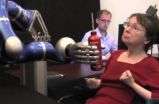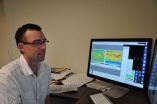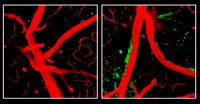(Press-News.org) In an ongoing clinical trial, a paralyzed woman was able to reach for and sip from a drink on her own – for the first time in nearly 15 years – by using her thoughts to direct a robotic arm. The trial, funded in part by the National Institutes of Health, is evaluating the safety and feasibility of an investigational device called the BrainGate neural interface system. This is a type of brain-computer interface (BCI) intended to put robotics and other assistive technology under the brain's control.
A report published today in Nature describes how two individuals – both paralyzed by stroke – learned to use the BrainGate system to make reach-and-grasp movements with a robotic arm, as part of the BrainGate2 clinical trial. The report highlights the potential for long-term use and durability of the BrainGate system, part of which is implanted in the brain to capture the signals underlying intentional movement. It also describes the most complex functions to date that anyone has been able to perform using a brain-computer interface.
For the woman, it was the first time since her stroke that she was able to sip a drink without help from a caregiver.
"The smile on her face was a remarkable thing to see. For all of us involved, we were encouraged that the research is making the kind of progress that we had all hoped," said the trial's lead investigator, Leigh Hochberg, M.D., Ph.D., who is an associate professor of engineering at Brown University in Providence, R.I. and a critical care neurologist at Massachusetts General Hospital (MGH)/Harvard Medical School in Boston.
"Years after the onset of paralysis, we found that it was still possible to record brain signals that carry multi-dimensional information about movement and that those signals could be used to move an external device," Dr. Hochberg said.
He noted that the technology is years away from practical use and that the trial participants used the BrainGate system under controlled conditions in their homes with a technician present to calibrate it.
The BrainGate neural interface system consists of a sensor to monitor brain signals and computer software and hardware that turns these signals into digital commands for external devices. The sensor is a baby aspirin-sized square of silicon containing 100 hair-thin electrodes, which can record the activity of small groups of brain cells. It is implanted into the motor cortex, a part of the brain that directs movement.
"This technology was made possible by decades of investment and research into how the brain controls movement. It's been thrilling to see the technology evolve from studies of basic neurophysiology and move into clinical trials, where it is showing significant promise for people with brain injuries and disorders," said Story Landis, Ph.D., director of NIH's National Institute of Neurological Disorders and Stroke (NINDS). The institute funds BCI research in hopes of restoring function and improving quality of life for people coping with limb amputations or paralysis from spinal cord injury, stroke or neuromuscular disorders.
NIH has supported basic and applied research in this area for more than 30 years. In 2009 and 2010, an additional $3.8 million in NIH funding was made possible through the Recovery Act.
The latest analysis from the BrainGate2 trial focused on two participants – a 58-year-old woman and a 66-year-old man. Both individuals are unable to speak or move their limbs because of brainstem strokes they had years ago - the woman's in 1996 and the man's in 2006. In the trial, both participants learned to perform complex tasks with a robotic arm by imagining the movements of their own arms and hands.
In one task, several foam targets were mounted on levers on a tabletop and programmed to pop up one at a time, at different positions and heights. The participants had less than 30 seconds to grasp each target using the DEKA Arm System (Generation 2), which is designed to work as a prosthetic limb for people with arm amputations. One participant was able to grasp the targets 62 percent of the time, and the other had a 46 percent success rate.
In some sessions, the woman controlled a DLR Light-Weight Robot III arm, which is heavier than the DEKA arm and designed to be used as an external assistive device. She used this arm prior to the DEKA arm in the foam target task, and had a success rate of 21 percent. In other sessions with the DLR arm, her task was to reach for a bottled drink, bring it to her mouth and sip from a straw. She was able to complete four out of six attempts.
This is not the first glimmer of hope from human BCI research. Participants in the BrainGate trial and other studies have also used BCI technology to perform point-and-click actions with a computer cursor, a level of control that has been used for communication.
"This is another big jump forward to control the movements of a robotic arm in three-dimensional space. We're getting closer to restoring some level of everyday function to people with limb paralysis," said John Donoghue, Ph.D., who leads the development of BrainGate technology and is the director of the Institute for Brain Science at Brown University.
Dr. Donoghue said the woman's ability to use the BrainGate was especially encouraging because her stroke occurred nearly 15 years ago and her sensor was implanted more than five years ago. Some researchers have wondered whether neurons in the motor cortex might die or stop generating meaningful signals after years of disuse. Researchers in the field have also worried that years after implantation, the sensor might break down and become less effective at enabling complex motor functions.
Roderic Pettigrew, M.D., Ph.D., director of NIH's National Institute of Biomedical Imaging and Bioengineering (NIBIB), which supports the research, indicated that the technology is promising, but at present is still undergoing development and evaluation. "The researchers have begun the long, difficult process of testing and refining the system with feedback from patients, and they've found that it is possible for a person to mentally control a robotic limb in three-dimensional space. This represents a remarkable advance," he said.
As the trial continues, the BrainGate research team needs to test the technology in more individuals, they said. They envision a system that would be stable for decades, wireless and fully automated. For now, the sensor – and therefore the user – must be connected via cables to the rest of the system. Prior to each session with the robotic arms, a technician had to perform a calibration procedure that lasted 31 minutes on average. Improvements are also needed to enhance the precision and speed of control. In the foam target task, for example, a successful reach-and-grasp motion typically took almost 10 seconds.
The ultimate goal for helping people with paralysis is to reconnect the brain directly to paralyzed limbs rather than robotic ones, the researchers said. In the future, the BrainGate system might be used to control a functional electrical stimulation (FES) device, which delivers electrical stimulation to paralyzed muscles. Such technology has shown promise in monkeys. The Eunice Kennedy Shriver National Institute for Child Health and Human Development (NICHD) has long supported the clinical trial research for BrainGate, with the goal of enabling mental control of an FES system for limb movement. In previous reports from the BrainGate2 trial, a participant was able to use the BrainGate system to direct the movements of a virtual, computer-animated arm designed to simulate FES control of a real arm.
To support this research, NIH has worked closely with the Department of Veterans Affairs (VA) and the Defense Advanced Research Projects Agency (DARPA), the research arm of the Department of Defense. DARPA supports development of the DEKA arm. Development of the DLR arm is funded by the German aerospace agency DLR. NIH has supported the fundamental neuroscience and BCI development, and the clinical research in collaboration with the VA. Drs. Hochberg and Donoghue hold research positions with the Providence VA Medical Center.
Dr. Donoghue is supported by a Javits Neuroscience Investigator award (NS025074) from NINDS, and by a grant (EB007401) from NIBIB and NICHD. The research is also supported by contracts (HD53403, HD100018) from NICHD's National Center for Medical Rehabilitation Research to Robert Kirsch, Ph.D., at Case Western Reserve University, Cleveland. Additional support came from an NIH Challenge grant (HD063931) to Dr. Donoghue and a grant (DC009899) from the National Institute on Deafness and other Communication Disorders (NIDCD) to Dr. Hochberg, which were funded all or in part through the Recovery Act.
The BrainGate trial began in 2004 and was run by Cyberkinetics Inc., in collaboration with Brown University and MGH. NICHD began funding the trial in 2005. After Cyberkinetics withdrew from the research for financial reasons, funding continued through this NICHD contract, MGH became the clinical trial and administrative lead, and the trial was renamed BrainGate2.
INFORMATION:
The trial is currently recruiting. For more information, visit: http://www.clinicaltrials.gov/ct2/show/NCT00912041 or http://www.braingate2.org.
Reference: Hochberg LR et al. "Reach and grasp by people with tetraplegia using a neurally controlled robotic arm." Nature, May 17, 2012, Vol. 485, pp. 372-375.
NIBIB is dedicated to improving health by bridging the physical and biological sciences to develop and apply new biomedical technologies.
NICHD sponsors research on development, before and after birth; maternal, child, and family health; reproductive biology and population issues; and medical rehabilitation.
NIDCD supports and conducts research and research training on the normal and disordered processes of hearing, balance, taste, smell, voice, speech and language and provides health information, based upon scientific discovery, to the public.
NINDS is the nation's leading funder of research on the brain and nervous system. The NINDS mission is to reduce the burden of neurological disease – a burden borne by every age group, by every segment of society, by people all over the world.
About the National Institutes of Health (NIH): NIH, the nation's medical research agency, includes 27 Institutes and Centers and is a component of the U.S. Department of Health and Human Services. NIH is the primary federal agency conducting and supporting basic, clinical, and translational medical research, and is investigating the causes, treatments, and cures for both common and rare diseases. For more information about NIH and its programs, visit http://www.nih.gov.
The activities described in this release are funded in part through the American Recovery and Reinvestment Act. More information about NIH's Recovery Act grant funding opportunities can be found at http://grants.nih.gov/recovery/. To track the progress of HHS activities funded through the Recovery Act, visit http://www.hhs.gov/recovery. To track all federal funds provided through the Recovery Act, visit http://www.recovery.gov.
NIH…Turning Discovery into Health
Paralyzed individuals use thought-controlled robotic arm to reach and grasp
NIH-funded study shows progress in brain-computer interface technology
2012-05-17
ELSE PRESS RELEASES FROM THIS DATE:
A deeper look at Centaurus A
2012-05-17
Centaurus A, also known as NGC 5128 [1], is a peculiar massive elliptical galaxy with a supermassive black hole at its heart. It lies about 12 million light-years away in the southern constellation of Centaurus (The Centaur) and has the distinction of being the most prominent radio galaxy in the sky. Astronomers think that the bright nucleus, strong radio emission and jet features of Centaurus A are produced by a central black hole with a mass of about 100 million times that of the Sun. Matter from the dense central parts of the galaxy releases vast amounts of energy as ...
Manmade pollutants may be driving Earth's tropical belt expansion
2012-05-17
RIVERSIDE, Calif. — Black carbon aerosols and tropospheric ozone, both manmade pollutants emitted predominantly in the Northern Hemisphere's low- to mid-latitudes, are most likely pushing the boundary of the tropics further poleward in that hemisphere, new research by a team of scientists shows.
While stratospheric ozone depletion has already been shown to be the primary driver of the expansion of the tropics in the Southern Hemisphere, the researchers are the first to report that black carbon and tropospheric ozone are the most likely primary drivers of the tropical ...
Understanding breast cancer
2012-05-17
In a study published today in Nature, researchers describe nine new genes that drive the development of breast cancer. This takes the tally of all genes associated with breast cancer development to 40.
The team examined all the genes in the genomes of 100 cases of breast cancer. The mutated cancer-causing genes were different in different cancer samples, indicating that breast cancer is genetically very diverse. Understanding the consequences of this diversity will be important in progressing towards more rational treatment.
Changes to DNA lie behind all cases of cancer. ...
Predicting cancer relapse: Study finds high-throughput sequencing bests flow cytometry
2012-05-17
SEATTLE – A study led by researchers at Fred Hutchinson Cancer Research Center has found that a next-generation, high-speed DNA-decoding technology called high-throughput sequencing can detect the earliest signs of potential relapse in nearly twice the number of leukemia patients as compared to flow cytometry, the current gold standard for detecting minimal residual disease. The results of the study, led by Hutchinson Center computational biologist Harlan Robins, Ph.D., are reported in the May 16 issue of Science Translational Medicine.
"The ability to predict disease ...
Dentist in Kentwood, MI Announces the Recent Launch of Hahn Dental Group's Mobile Website
2012-05-17
While the mobile community continues to grow, Dr. Hahn, dentist in Kentwood, MI, is happy to offer an advanced mobile website to better meet the needs of patients who are constantly on the go. Today, in a technologically advanced society, more and more people are utilizing their smart phones and tablet devices for their daily needs. From ordering food to looking up important information, patients use their smart phones and tablet devices on a daily basis.
By offering a mobile website, Dr. Hahn, dentist in Kentwood, enhances his patients' ability to receive important ...
NIH-funded research provides new clues on how ApoE4 affects Alzheimer's risk
2012-05-17
Common variants of the ApoE gene are strongly associated with the risk of developing late-onset Alzheimer's disease, but the gene's role in the disease has been unclear. Now, researchers funded by the National Institutes of Health have found that in mice, having the most risky variant of ApoE damages the blood vessels that feed the brain.
The researchers found that the high-risk variant, ApoE4, triggers an inflammatory reaction that weakens the blood-brain barrier, a network of cells and other components that lines brain's brain vessels. Normally, this barrier allows ...
Saginaw Township Dentist Improves Practice Through Patient Reviews
2012-05-17
Dr. Greg Herzler, Saginaw Township dentist, appreciates his patients' feedback about his practice. By leaving reviews, patients help Dr. Herzler to improve his practice to better serve his patients. Patients can visit the practice's website for instant access to available links to leave their feedback on the review site of their choice.
"I always look forward to hearing from my patients about their experience with my office. By leaving reviews, my patients allow me to constantly improve my practice and the way we serve our patients. I hope to continue to provide ...
Movement patterns of endangered turtle vary from Pacific to Atlantic
2012-05-17
The movement patterns of critically endangered leatherback turtles vary greatly depending on whether the animals live in the North Atlantic or the Eastern Pacific, with implications for feeding behavior and population recovery, according to research published May 16 in the open access journal PLoS ONE.
The authors, led by Helen Bailey of the University of Maryland Center for Environmental Science, found that turtles in the Atlantic had two travel modes, low and high speed, associated with foraging and transit, respectively. The Pacific turtles, on the other hand, only ...
'Last resort' antibiotics increasingly used to fight multidrug-resistant bugs
2012-05-17
Multidrug-resistant pathogens are becoming more frequent, and the few "last resort" treatments available for infections with these bacteria have also shown an increase in use in recent years, according to a study published May 16 in the open access journal PLoS ONE.
The authors, led by Makoto Jones of the Veterans Affairs Salt Lake City Health Care System, investigated the use of two such antibiotics, polymyxins and tigecycline, in 127 Veterans Affairs medical centers between 2005 and 2010. They found that the overall use of these treatments was quite low, but that it ...
Dentist in Flushing and Flint, MI Offers New Procedure for Improved Dental Care
2012-05-17
Leading dentist in Flushing and Flint, MI, Dr. Scott Pelok, is pleased to introduce the practice's newest piece of dental technology- the Galileos 3D cone beam scanner. The new dental diagnostic system is helping the practice continue to bring patients the most efficient, comfortable and effective dentistry possible.
The new Galileos 3D diagnostic system allows Dr. Pelok and his team to create a precise 3D image of a patient's entire jaw in a matter of seconds- in significantly less time than traditional x-rays. The Galileos advanced technology allows patients to be ...
LAST 30 PRESS RELEASES:
Practical education: Clinical scenario-based program development
The impact of family dynamics on eating behaviour – how going home for Christmas can change how you eat
Tracing the quick synthesis of an industrially important catalyst
New software sheds light on cancer’s hidden genetic networks
UT Health San Antonio awarded $3 million in CPRIT grants to bolster cancer research and prevention efforts in South Texas
Third symposium spotlights global challenge of new contaminants in China’s fight against pollution
From straw to soil harmony: International team reveals how biochar supercharges carbon-smart farming
Myeloma: How AI is redrawing the map of cancer care
Manhattan E. Charurat, Ph.D., MHS invested as the Homer and Martha Gudelsky Distinguished Professor in Medicine at the University of Maryland School of Medicine
Insilico Medicine’s Pharma.AI Q4 Winter Launch Recap: Revolutionizing drug discovery with cutting-edge AI innovations, accelerating the path to pharmaceutical superintelligence
Nanoplastics have diet-dependent impacts on digestive system health
Brain neuron death occurs throughout life and increases with age, a natural human protein drug may halt neuron death in Alzheimer’s disease
SPIE and CLP announce the recipients of the 2025 Advanced Photonics Young Innovator Award
Lessons from the Caldor Fire’s Christmas Valley ‘Miracle’
Ant societies rose by trading individual protection for collective power
Research reveals how ancient viral DNA shapes early embryonic development
A molecular gatekeeper that controls protein synthesis
New ‘cloaking device’ concept to shield sensitive tech from magnetic fields
Researchers show impact of mountain building and climate change on alpine biodiversity
Study models the transition from Neanderthals to modern humans in Europe
University of Phoenix College of Doctoral Studies releases white paper on AI-driven skilling to reduce burnout and restore worker autonomy
AIs fail at the game of visual “telephone”
The levers for a sustainable food system
Potential changes in US homelessness by ending federal support for housing first programs
Vulnerability of large language models to prompt injection when providing medical advice
Researchers develop new system for high-energy-density, long-life, multi-electron transfer bromine-based flow batteries
Ending federal support for housing first programs could increase U.S. homelessness by 5% in one year, new JAMA study finds
New research uncovers molecular ‘safety switch’ shielding cancers from immune attack
Bacteria resisting viral infection can still sink carbon to ocean floor
Younger biological age may increase depression risk in older women during COVID-19
[Press-News.org] Paralyzed individuals use thought-controlled robotic arm to reach and graspNIH-funded study shows progress in brain-computer interface technology



